BY ARTURO ARNALICH
During the 2014 International Fire Instructors Workshop (IFIW) in Olsztyn, Poland, I proposed and presented the discussion topic “Tools, Techniques, and Tactics (3T) in Combination for Firefighting,” intending to introduce the concept of tactical combination for safer, more efficient, and more effective firefighting operations and to encourage a debate among my colleagues.
To illustrate the 3Ts in combination, I used the combined fire attack concept, a tactical combination developed in our fire department and found extremely useful in firefighting in our operational area. Later on, during the IFIW practical session, we had the opportunity to perform an evolution using combined fire attack.
Tactical combination is all about using the right tool, technique, and tactic in each situation during a firefighting operation. It requires teamwork, skilled incident command, and a dynamic size-up of the fire scene. Timing and coordination are key to a successful tactical combination.
COMBINED FIRE ATTACK
A combined fire attack is a coordinated and timed fire attack using transitional attack, gas-cooling techniques, and positive-pressure attack (PPA) tactics.
In today’s fire environment, we often find underventilated fires (ventilation-controlled fires that have not yet gone through a flashover stage) with no clear stratification of the smoke and air layers, resulting in almost zero visibility and very slow operations in complex structures.
Recent studies by Underwriters Laboratories (UL) have shown and proven how rapidly modern fuel ventilation-controlled fires react to ventilation. As soon as ventilation occurs, there is a limited time frame-less than two minutes in most cases-during which to apply water on the fire before it evolves into a ventilation-induced flashover (Figure 1).
| Figure 1. Modern vs. Legacy Fires Response to Ventilation |
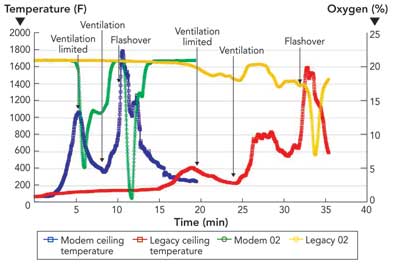 |
| A legacy fuel fire took more than eight minutes to reach flashover after a door was opened; a modern fuel fire took barely two minutes. Source: Underwriters Laboratories Fire Service Research Institute. |
The idea behind combined fire attack is to apply water from a safe position into the fire compartment to reduce fire gases’ temperature and flammability to a safe point, after which you can apply positive-pressure ventilation (PPV) with less concern about fire growth. PPV will improve interior conditions, increasing tenability for victim and faster interior team progress.
A firefighting operation is not only about fire suppression; it also involves search and rescue operations and making the egress path safe for any occupants inside the building. By using PPV for fire attack, you can clear smoke-filled areas and pressurize parts of the structure by opening and closing the appropriate windows at a given time. Thus, it combines easily with the complete range of defensive PPV, fire isolation, and flow-path control approaches.
COMBINED FIRE ATTACK EVOLUTION
1 Vent is opened. The vent closest to the seat of the fire is opened if it was closed. Shortly after, this will create a bidirectional flow through the window. Depending on the building, you can make vents using a pike pole from ground level, from a ladder, or from an aerial apparatus (Figure 2).
| Figure 2. Fire After Opening the Vent |
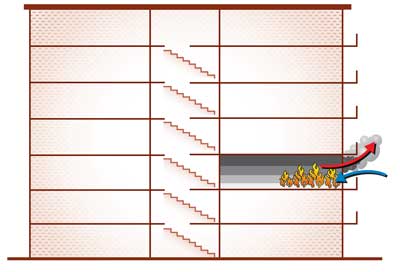 |
2 Transitional attack begins through the opened vent. A solid stream is directed to the ceiling of the structure, where it is deflected and broken down into smaller droplets. Although there is some direct attack on the fuel surfaces that the droplets hit, the main objective is to reduce the temperature of the hot gas layer.
You use a solid stream to minimize the interference of the air and smoke flows through the window. A fog nozzle pattern would surely be more effective for cooling gases, but it would require a larger area to entrain. The exhaust could be obstructed, preventing steam from exiting the structure. Fire gases would be displaced somewhere else, and the flow path would be altered.
You can perform transitional attack from the ground level or from an aerial apparatus. It should start as soon as a clear outward flow of ignitable hot fire gases is identified. This does not necessarily mean visible flames. It should continue based on fire conditions, keeping in mind that the goal is to “reset the fire” and not to flood the fire room.
Ten-second water applications at 200 liters per minute (lpm) followed by a waiting period to gain thermal stratification can be enough to “soften the target,” as some like to call this tactic.
Moving the solid stream while applying water may block the structure and will hit a larger ceiling area, resulting in more steam without significantly improving the result.
3 Gas cooling from the entrance door. As soon as the attack team reaches the entrance door, it applies a fog pattern stream from the outside. The door remains open just for the short time the nozzleman needs to apply water. Short pulsing has proven to have a limited reach. In underventilated fire conditions with no clear layer at the bottom, disrupting the thermal balance should not be an issue; therefore, a narrower cone, deeper reach, and longer and oscillating pulsing would be more effective (Figure 3).
| Figure 3. Gas Cooling and Transitional Attack |
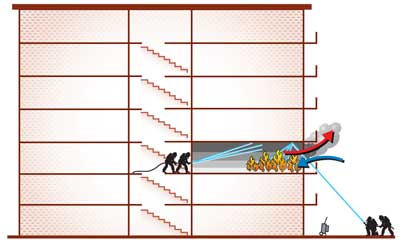 |
4 PPA on the softened fire. Once the flammability of the fire gases and the interior temperature have been reduced, a PPA can begin. A flow path is created from the entrance door to the window at which the transitional attack was performed. Excess smoke and steam will be removed rapidly. Fire reaction to ventilation will be milder because of the “softened” conditions prior to PPV (Figure 4).
| Figure 4. Positive Pressure Attack on the Softened Fire |
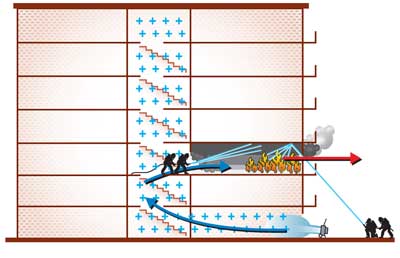 |
The attack team should remain outside at the entrance door until interior conditions and visibility improve. This will take a short time, after which the team can make fast interior progress. Use gas cooling to reduce the flammability of the fire gases and the entrained fresh air mixture.
After the interior team reaches the seat of the fire and performs a direct attack, the fire is under control. During this stage, crews performing interior attack will feel fresh air blowing on their backs and there will be little or no steam because a PPV fan is reinforcing the flow path, redirecting the excess steam downstream (Figure 5).
| Figure 5. More Gas Cooling and Transitional Attack |
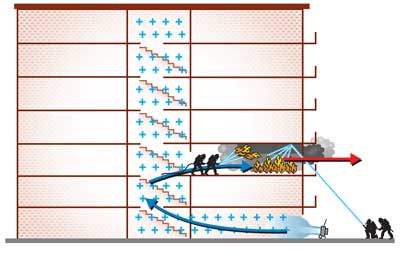 |
After the fire is under control, search and rescue operations begin. Nevertheless, shortly after PPV starts, tenability for victims is improved as a fresh layer of cold breathable air spreads throughout the structure from the bottom (Figure 6).
| Figure 6. Direct Attack on the Seat of the Fire |
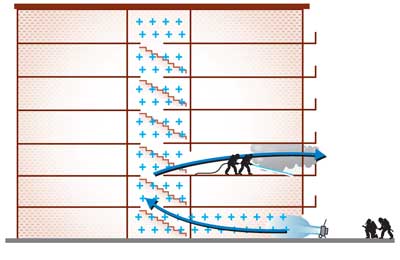 |
USING TECHNIQUES ALONE VS. IN COMBINATION
Gas cooling. Gas cooling has been used widely throughout Europe, Australia, and some Asian countries. It has proven to be a reliable and effective way to reduce fire gases’ ignition risk as crews make interior progress. The pulses of water fog cool and dilute the upper hot gas fire layer. Water fog expands into steam at a lower rate than the fire gas layer contracts. Hence, it preserves the thermal balance and is the best way to maintain visibility in the lower area (Figure 7).
| Figure 7. Traditional European Gas Cooling |
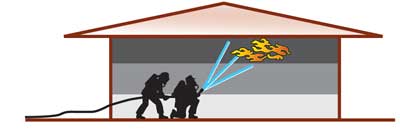 |
However, as it was said before, most underventilated fires don’t stratify clearly, and the neutral plane descends nearly to the floor. Gas cooling is effective in terms of reducing flammability, but it will not create a clear bottom layer unless a fresh supply of air is introduced and a flow path is created.
Making interior progress in zero visibility takes a significant amount of time. Crews are exposed to high temperatures for longer, and there is a significant risk of not finding the correct path to the seat of the fire in complex structures.
The combined use of transitional attack will reduce interior temperature for easier interior progress while PPA will rapidly improve visibility.
Transitional attack. UL’s studies have proven that transitional attack reduces temperature throughout the whole structure, not just in the fire room. Most concerns about this tactic involve excess steam inside and on the interior crew making progress. Inappropriate water application (cone pattern stream or moving solid stream) could also possibly prevent the exit of fire gases and steam from the compartment (Figure 8).
| Figure 8. Transitional Attack Concerns |
 |
Using a PPV fan to create and ensure a flow path will, in most cases, avoid exposing interior crews to steam as they progress along with the fresh air stream. Inappropriate water flow rates or application will have less impact as excess steam is directed toward the exhaust opening and it is harder to block the window with the exterior water application.
PPA. Although PPA improves interior conditions for fire attack, a delay in water application or inappropriate inlet and exhaust sizes may disturb the fire gas mix and result in fire growth or even a ventilation-induced flashover scenario. Modern fuel fires respond to ventilation more violently and reduce the time frames to reach the fire seat before growth.
Transitional attack combined with gas cooling from the entrance door will reduce the interior temperature and, therefore, increase the time needed for fire growth, allowing for a safer and more effective PPA (Figure 9).
| Figure 9. Transitional, Positive-Pressure Attack, and Gas Cooling |
 |
A combination of gas cooling, transitional attack, and PPA can result in a safer, more efficient, and more effective firefighting operation vs. employing each tactic alone. Fire scenario assessment, timing, and coordination are essential for success.
ARTURO ARNALICH is a battalion chief with CEIS Guadalajara, a fire department protecting 200,000 people in metropolitan Madrid. He is responsible for the operational division and served as training division chief for six years. Arnalich received a master’s degree in civil and environmental engineering from Madrid Polytechnic University in 1998. A participant in the International Fire Instructors Workshop (IFIW), he focuses on tactics and fire ventilation and serves on Underwriters Laboratories technical panel for the positive-pressure ventilation study.
Fire Engineering Archives

